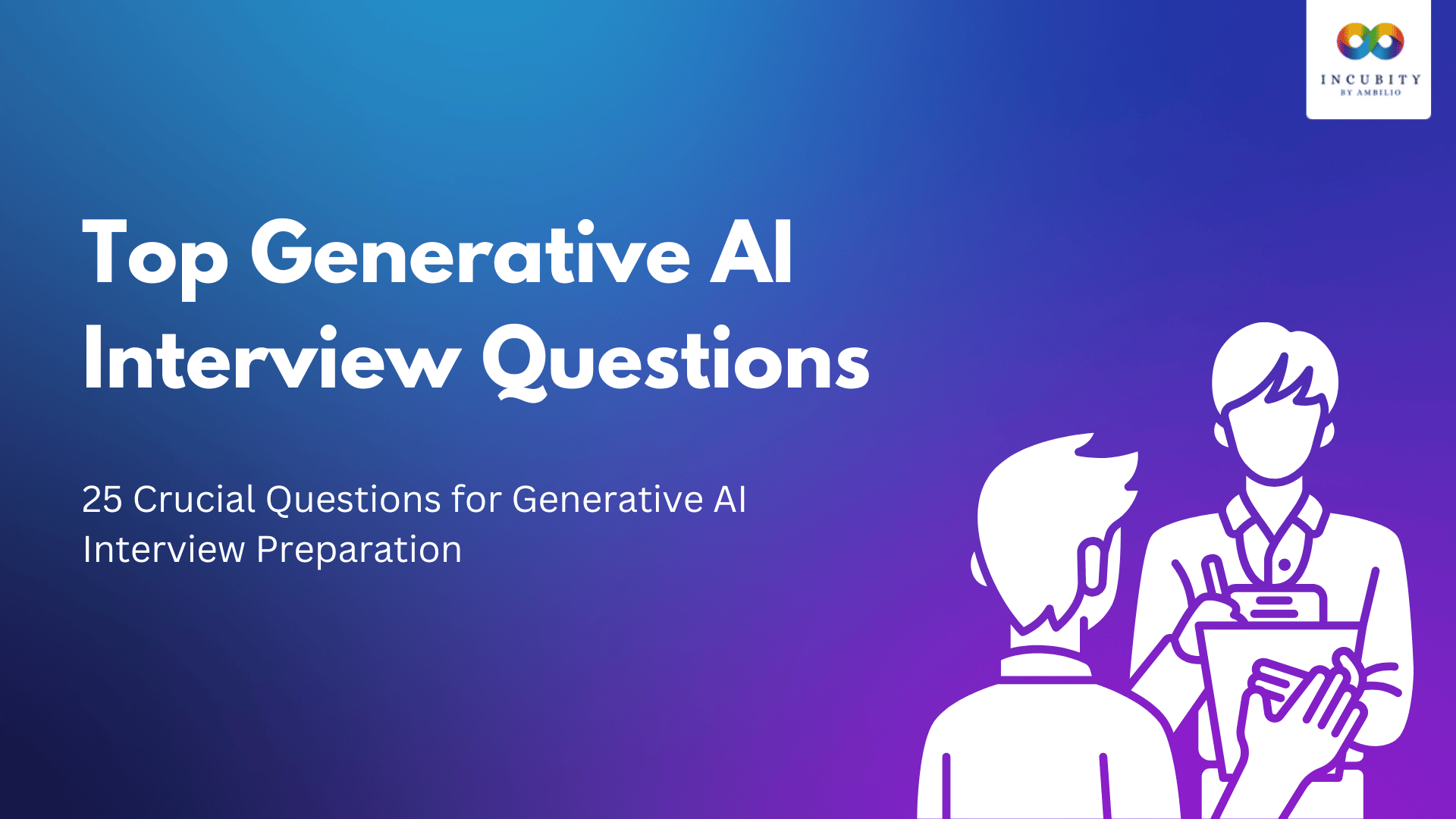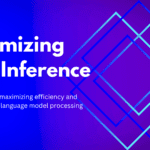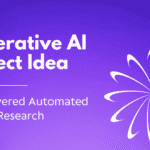Generative AI has emerged as a groundbreaking field, revolutionizing the way machines generate content, create art, and simulate human-like behaviors. As organizations increasingly integrate Generative AI into their workflows, the demand for skilled professionals in this domain continues to rise. To help aspiring candidates prepare for interviews and gain a deeper understanding of the field, this article delves into top 25 Generative AI Interview Questions related to key topics essential for mastering Generative AI. Whether you’re a seasoned practitioner or a novice enthusiast, this compilation serves as a valuable resource for honing your expertise and excelling in Generative AI discussions.
Generative AI Interview Questions
Question 1: How does transfer learning contribute to advancing Generative AI?
Answer: Transfer learning allows for the reuse of pretrained models or knowledge from one domain to another within Generative AI. This process reduces training times and enhances generalization capabilities by leveraging existing knowledge.
Question 2: Can you elaborate on adversarial attacks and their impact on Generative AI systems?
Answer: Adversarial attacks involve exploiting vulnerabilities in Generative AI systems to disrupt their functioning. Attackers employ techniques such as perturbations to cause incorrect predictions or compromise the integrity of the system.
Question 3: What methods are available for assessing the fidelity of outputs generated by Generative AI systems?
Answer: Techniques like Fréchet Inception Distance (FID), Precision-Recall Curves (PRC), and Structural Similarity Index Measure (SSIM) are commonly used to evaluate the similarities between generated outputs and reference data in Generative AI.
Question: 4 How does Generative AI intersect with human creativity and intelligence?
Answer: While Generative AI demonstrates remarkable creative abilities, it still falls short of fully emulating human cognition and intuitive decision-making processes. Nonetheless, collaboration between humans and machines may lead to innovative solutions and advancements.
Question 5: Discuss the relationship between Generative AI and Deep Learning.
Answer: Generative AI heavily relies on deep learning methodologies, particularly neural networks, to achieve cutting-edge results. Deep learning techniques form the backbone of many Generative AI models, enabling them to learn complex patterns and generate realistic outputs.
Question 6: What impact does Generative AI have on various industries and society as a whole?
Answer: Generative AI presents vast opportunities across numerous sectors, including art, entertainment, healthcare, finance, and education. However, it also raises concerns regarding job displacement, privacy breaches, and ethical considerations that need to be addressed.
Question 7: What role does interpretability play in the development and deployment of Generative AI systems?
Answer: Interpretability is crucial in understanding how Generative AI systems operate. It enables researchers and practitioners to identify potential issues, make informed decisions, and ensure responsible usage of these systems.
Question 8: Why is scalable computing infrastructure essential for advancing Generative AI?
Answer: Scalable computing infrastructure is vital for the development and deployment of advanced Generative AI systems capable of handling massive datasets and computationally intensive tasks. It enables researchers to experiment with larger models and deploy them efficiently in real-world applications.
Question 9: What is the significance of multi-head attention in transformer models like GPT and LLaMA?
Answer: Multi-head attention is crucial in transformer models as it allows the model to focus on different parts of the input sequence simultaneously. This capability enhances the model’s ability to capture complex relationships within the data, leading to more comprehensive and accurate outputs.
Question: 10 How does Gemini leverage multi-query attention to improve the efficiency of multi-head attention in its architecture?
Answer: Gemini enhances the efficiency of multi-head attention by employing multi-query attention, which shares key and value vectors between attention heads. This approach reduces redundancy and computational overhead, thereby making the multi-head attention mechanism more efficient.
Question 11: What sets LLaMA 2 apart from other large language models like GPT concerning attention mechanisms?
Answer: LLaMA 2 differentiates itself by utilizing grouped query attention instead of traditional multi-head attention. In grouped query attention, query heads are divided into groups, sharing key and value heads. This division enhances processing efficiency, making LLaMA 2 more efficient in handling attention mechanisms.
Question 12: In what ways does Gemini’s architecture optimize training efficiency and stability compared to other multimodal LLMs like GPT-4V?
Answer: Gemini employs several optimization techniques to enhance training stability and efficiency. It incorporates the Lion optimizer and Low Precision Layer Normalization, which contribute to improved stability during training. Additionally, Gemini’s focus on multimodal tasks allows it to achieve state-of-the-art performance on benchmarks like MMMU, showcasing its efficiency and stability compared to other multimodal LLMs.
Question 13: How do models like GPT, LLaMA, and Gemini utilize transformer architectures with specific modifications for efficient training and inference on specialized tasks?
Answer: Models like GPT, LLaMA, and Gemini leverage transformer architectures with tailored modifications for various tasks. For instance, they utilize decoder-only transformer architectures optimized for tasks involving text, images, audio, video, and code. These modifications enable efficient training and inference across diverse modalities, ensuring scalability and performance in specialized tasks.
Question 14: What is Retrieval-Augmented Generation (RAG), and how does it contribute to enhancing Generative AI capabilities?
Answer: Retrieval-Augmented Generation (RAG) integrates retrieval-based methods with generative models to elevate content generation. By leveraging external knowledge sources, RAG refines outputs for heightened accuracy and contextual relevance in Generative AI.
Question 15: How do Vector Databases bolster semantic search within Generative AI applications?
Answer: Vector Databases play a pivotal role in semantic search by storing data point embeddings in a high-dimensional space. This enables efficient similarity searches, crucial for tasks such as information retrieval and recommendation systems in Generative AI applications.
Question 16: Could you elaborate on the concept of Large Language Models (LLMs) within the realm of Generative AI?
Answer: Large Language Models (LLMs) are sophisticated deep learning architectures, often comprising millions or even billions of parameters. Trained extensively on vast text corpora, LLMs excel in various natural language processing tasks like text generation, translation, and summarization, thereby enriching Generative AI capabilities.
Question 17: What are the common evaluation metrics used to gauge the performance of Large Language Models (LLMs) in Generative AI?
Answer: Evaluation metrics encompass perplexity, BLEU score, ROUGE score, METEOR score, F1 score, and human evaluation criteria. These metrics assess various facets such as coherence, relevance, diversity, and fluency of the generated text, ensuring comprehensive evaluation of LLMs in Generative AI.
Question 18: Can you delve into the operational principle of Stable Diffusion within Generative AI models?
Answer: Stable Diffusion is a method employed by generative models to refine noisy inputs iteratively, thereby generating high-quality samples. Through a diffusion process, this technique ensures the production of realistic outputs, enhancing the overall fidelity of Generative AI models.
Question 19: Define zero-shot learning and few-shot learning in the context of Generative AI and elucidate their distinctions.
Answer: Zero-shot learning involves training models to recognize classes not encountered during training, whereas few-shot learning entails training models with a limited number of examples per class. The fundamental difference lies in the availability of training data for each class.
Question 20: Highlight the significance of fine-tuning Large Language Models (LLMs) in Generative AI applications.
Answer: Fine-tuning LLMs involves adapting pretrained models to specific tasks or domains by further training them on task-specific data. This practice significantly enhances model performance on targeted tasks without necessitating extensive training from scratch, thereby optimizing Generative AI applications.
Question 21: Discuss the functionalities and advantages offered by LangChain and LlamaIndex in Generative AI contexts.
Answer: LangChain facilitates cross-lingual information retrieval by establishing links between languages through shared embeddings. Conversely, LlamaIndex serves as a scalable index structure, facilitating efficient similarity searches essential for large-scale generative models, thereby enriching Generative AI applications.
Question 22: Could you shed light on the operational mechanisms of LoRA (Local Rank Aggregation) and QLoRA (Query-based Local Rank Aggregation) in enhancing semantic search capabilities within Generative AI systems?
Answer: LoRA enhances search result quality by aggregating local ranking scores from multiple sources. In contrast, QLoRA further refines ranking results by considering query-specific information, thereby optimizing semantic search capabilities based on user intent or context in Generative AI systems.
Question 23: How do Generative Adversarial Networks (GANs) leverage adversarial training to generate realistic data samples, and what are some key challenges associated with training GANs?
Answer: GANs use a generator and a discriminator network in a minimax game during training. The generator produces synthetic data, while the discriminator distinguishes real from fake samples. Challenges include mode collapse, vanishing gradients, and training instability.
Question 24: What role do reinforcement learning techniques like policy gradient methods play in training Generative AI models, particularly in scenarios involving sequential decision-making tasks?
Answer: Reinforcement learning (RL), such as policy gradient methods like REINFORCE, optimizes model parameters to maximize expected rewards in sequential decision-making tasks. RL enables Generative AI models to learn complex behaviors for applications like autonomous navigation and game playing.
Question 25: How does Gemini optimize training efficiency and stability compared to other multimodal LLMs like GPT-4V?
Answer: Gemini incorporates optimization techniques like the Lion optimizer and Low Precision Layer Normalization, enhancing training stability. Focusing on multimodal tasks, Gemini achieves state-of-the-art performance on benchmarks like MMMU.
In summary, these 25 Generative AI Interview Questions provide a comprehensive overview of Generative AI and Large Language Models (LLMs), covering key concepts, techniques, and applications. As the field continues to expand, mastering these topics is essential for professionals seeking to excel in the dynamic and rapidly evolving domain of AI.



